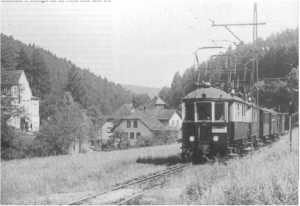BLEAG ET 1–8
| BLEAG ET 1–8 | |
|---|---|
|
historical recording
|
|
| Numbering: | 1 to 8 |
| Number: | 8th |
| Manufacturer: | mechanical: Herbrand wagon factory electrical: AEG |
| Year of construction (s): | 1910/11 |
| Retirement: | until 1964 |
| Axis formula : | (A1) (1A) |
| Gauge : | 1000 mm ( meter gauge ) |
| Length over buffers: | 13,300 mm |
| Width: | 2,500 mm |
| Trunnion Distance: | 6,500 mm |
| Bogie axle base: | 1,800 mm |
| Service mass: | 25,000 kg |
| Top speed: | 40 km / h |
| Continuous output : | 2 × 60 kW |
| Wheel diameter: | 1,000 mm |
| Power system : | 8,800 V 25 Hz ~ |
| Power transmission: | Overhead line |
| Number of traction motors: | 2 |
| Brake: | Hardy brake |
| Seats: | 48 |
| Classes : | 3. |
The BLEAG ET 1–8 were eight four-axle electric railcars from Badische Lokal-Eisenbahnen AG (BLEAG), which were used on the originally meter-gauge Alb Valley Railway from Karlsruhe to Bad Herrenalb , the Busenbach – Pforzheim railway and the Ettlinger Seitenbahn . The vehicles were in service until around 1964 and were then taken out of service. None of the vehicles remained.
history
In addition to locomotives 1 to 4 for freight transport, BLEAG also procured four-axle railcars for passenger transport, which were also supplied by the Herbrand wagon factory and AEG . These were sometimes used together with a control car . The vehicles had the option of multiple control ; Two railcars could be controlled from one platform, so that often two railcars were in use together with a trailer / control car.
Although the Albtalbahn was under fire from low-flying attacks during World War II , all vehicles survived the war and then continued to operate until the routes were re-tracked. The last vehicles were only used on the Ittersbach route after three vehicles had been parked due to damage in 1959 and 1961. In 1964, the last vehicles were also retired and scrapped soon after.
construction
The vehicles were built mechanically by the Herbrand wagon factory in Cologne and the electric ones by AEG . The vehicles were equipped with two Winter Eichberg engines, which were housed in maximum bogies . The vehicles were equipped with two pantographs with simple contact strips, both of which were usually attached.
At the end points of the vehicles, the driver's cabs with the driving switch , driver's brake valve , hand brake lever, sand spreader and the dashboard were available. The drive switch was provided with a dead man's device , which automatically braked the railcar when the drive switch lever was released or interrupted the power interruption to the drive motors. To increase the braking force of the Hardy brake , an additional auxiliary air tank was built into the railcar. The ET had only one vacuum pump in the driver's cab in the direction of Karlsruhe. The compressor for this switches on automatically at two bar and automatically off at six bar.
The course of the current was designed somewhat differently than with the electric locomotives; In the railcars, the contactor control switches were switched between the transformer and traction motors. This made it possible to control several railcars from one driver's cab if they were connected to a high-voltage coupling. In the direction of Bad Herrenalb station, all vehicles were always in the direction of the front . This was especially important when locating hot runners for the workshop.
literature
- Meinhard Döpner: The Deutsche Eisenbahn Betriebs-Gesellschaft AG . In: Verlag Zeit und Eisenbahn . Lokrundschau Verlag GmbH, Gülzow 2002, ISBN 3-931647-13-7 .
- Gerd Wolff, Hans-Dieter Menges: German small and private railways. Volume 2: Bathing . EK-Verlag, Freiburg 1992, ISBN 3-88255-653-6 , p. 38-41 .
Individual evidence
- ↑ Meinhard Doepner: The German railway operating company AG . In: Verlag Zeit und Eisenbahn . Lokrundschau Verlag GmbH, Gülzow 2002, ISBN 3-931647-13-7 , p. 146 .
- ↑ a b Meinhard Doepner: The German railway operating company AG . In: Verlag Zeit und Eisenbahn . Lokrundschau Verlag GmbH, Gülzow 2002, ISBN 3-931647-13-7 , p. 148 .
